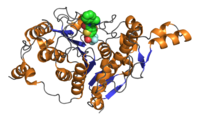
Photo from wikipedia
AIMS Epigenetic regulation plays an important role in the progression of Alzheimer's disease (AD). Here, we identified differential methylation probes (DMP) and investigated their potential mechanistic roles in AD. MAIN… Click to show full abstract
AIMS Epigenetic regulation plays an important role in the progression of Alzheimer's disease (AD). Here, we identified differential methylation probes (DMP) and investigated their potential mechanistic roles in AD. MAIN METHODS DMPs were identified via bioinformatic analysis of GSE66351, which was made up with 106 AD samples and 84 control samples derived from three separate brain regions. Differentially expressed genes (DEGs) were analyzed based on GSE5281 comprising 45 control samples and 58 AD samples. Gene ontology (GO), gene set enrichment analysis (GSEA), and protein-protein interaction (PPI) were used to identify pathways and hub genes. KEY FINDINGS We found 9007 DMPs in Occipital Cortex glia, 1527 in OC neurons, 100 in Temporal Cortex, and 194 in Frontal Cortex. 74 DEGs were identified in Primary Visual Cortex, 67 of which were downregulated while seven upregulated. 482 were upregulated and 697 downregulated in medial temporal gyrus. In superior frontal gyrus, 687 were upregulated and 85 downregulated. GO and PPI revealed that pathways involving epithelial-cell differentiation, cellular responses to lipids, transcription corepressor activities, apoptotic and organ growth were modulated by histone deacetylase 1 (HDAC1) and associated with AD. Additionally, GSEA illustrated that the transforming growth factor beta signaling pathway was significantly enriched in some brain regions and HDAC1 played an important role in this pathway. SIGNIFICANCE We found the glial-specific 3'UTR of HDAC1 was hypermethylated and HDAC1 was overexpressed in AD patients. Moreover, we also speculate that HDAC1 triggered signaling pathways linked to many different biological processes and functions via the regulation of histone deacetylation.
Journal Title: Life sciences
Year Published: 2020
Link to full text (if available)
Share on Social Media: Sign Up to like & get
recommendations!